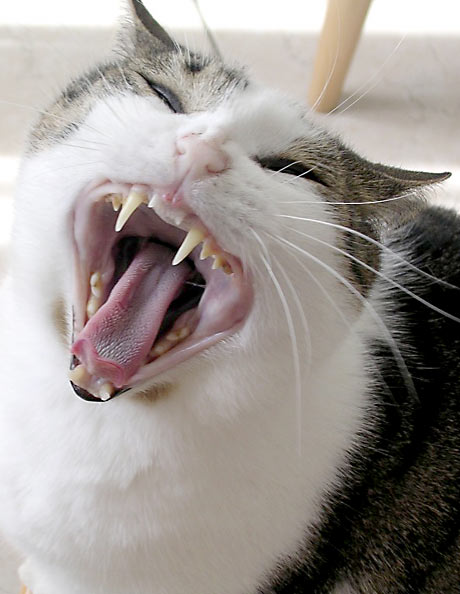Cats: Physiology, Sociology, Communication
Wikipedia readings on: Cat, Catnip (aka nepeta). Some excerpts:
A group of cats is referred to as a clowder, a male cat is called a tom, and a female is called a queen. The male progenitor of a cat, especially a pedigreed cat, is its sire, and its female progenitor is its dam.
The male cat's penis has spines which point backwards. Upon withdrawal of the penis, the spines rake the walls of the female's vagina. The female needs this stimulation for ovulation to begin. Because this does not always occur, females are rarely impregnated by the first male with which they mate. Furthermore, cats are superfecund; that is, a female may mate with more than one male when she is in heat, meaning different kittens in a litter may have different fathers.
The reproduction process can be very loud, as both cats vocalize loudly. If one is not used to the sounds of cats mating, it will sound like a cat fight.
Despite its reputation as a solitary animal, the domestic cat is social enough to form colonies, but does not attack in groups as lions do. Some breeds like bengal, ocicat and manx are very social, but are exceptions. While each cat holds a distinct territory (sexually active males having the largest territories, and neutered cats having the smallest), there are “neutral” areas where cats watch and greet one another without territorial conflicts. Outside these neutral areas, territory holders usually aggressively chase away stranger cats, at first by staring, hissing, and growling, and if that does not work, by short but noisy and violent attacks. Fighting cats make themselves appear more impressive and threatening by raising their fur and arching their backs, thus increasing their visual size. Cats also behave this way while playing. Attacks usually comprise powerful slaps to the face and body with the forepaws as well as bites, but serious damage is rare; usually the loser runs away with little more than a few scratches to the face, and perhaps the ears. Normally, serious negative effects will be limited to possible infections of the scratches and bites; though these have been known to sometimes kill cats if untreated. In addition, such fighting is believed to be the primary route of transmission of feline immunodeficiency virus (FIV). Sexually active males will usually be in many fights during their lives, and often have decidedly battered faces with obvious scars and cuts to the ears and nose. Not only males will fight; females will also fight over territory or to defend their kittens, and even neutered cats will defend their (smaller) territories aggressively.

Wikipedia going crazy… with the huge quantity of people in modern society having nothing to do daily. Witness the profusion and in-depth-ness and photos gratis on the trivia of their loneliness meliorator: Cat communication, Kneading (cats), Purr, Cat body language
If you read all of the above, you'll not only learn quite a lot about no-nonsense sciences (hard-core cream from aspects of biology, ethology, ecology, sociology…: mating behavior, animal communication, scents and senses, anatomy, human societal problems (e.g. feral cat), castration effects on animal's social status … but also the funny tongue-in-cheek styles here and there from cat lovers.
Also note: that the declawing process, mostly practiced in USA, is basically surgical amputation of the cat's finger tips. From the anthropology perspective, this is one of the measures done to please pet or slave owners. There are already incredible amount of breeding to produce all types of pets with specialized characteristics, from appearance to temperament.
The article mentioned some aspects sociology of neutered cat. For some comment on castration, see: Body and Mind Modification (2003).
What is The Difference Between Panther, Leopard, Cougar, Puma?
So, what's the diff between panther, leopard, cougar, puma?
Some Wikipedia readings:
The four big cats are: tiger, lion, jaguar, leopard. I don't like lions, i think they are ugly, male or female. I like tiger, for its power and lone nature. I like leopard too, they are extremely beautiful. I don't have a clear picture of jaguar, it seems to be in-between tiger and leopard. Cougar, panther, puma, mountain lion, are pretty much synonyms. Another cat of interest is cheetah. They have the distinction of being the fastest runner. 112 km/h in short burst. Cheetah looks funny in comparison to other cats. It looks scrawny, with a round head with black strips around the eyes.
Among them, tiger is close to extinction, and second is lion and cheetah.